Category: Uncategorized
The Ultimate Guide to Pool Resurfacing: Materials, Costs, and Benefits
Your pool is the centerpiece of outdoor entertainment, it’s a sanctuary for relaxation and rejuvenation in your own backyard. However, over time, wear and tear can take a toll on its surface, reducing its aesthetic appeal and functionality. If your pool is showing signs of deterioration, then a swimming pool remodel through resurfacing may be in order. In this blog, we provide a comprehensive overview of pool resurfacing options.
Materials
When it comes to swimming pool remodeling, picking the right surface is crucial in enhancing aesthetics, durability, and longevity. Here are some popular options to consider:
- Plaster: Plaster is one of the most common and affordable pool resurfacing materials. It is made up of a mixture of cement, sand, and water. Once applied it offers a smooth finish. It comes in a variety of colors allowing you to customize the look of your pool to your taste. Although plaster is cost-effective, it will require more maintenance and is prone to staining and cracking over time.
- Pebble Tec: Pebble Tec is a more premium option and is made up of natural pebbles and a cement-like binder. This will result in a surface that is textured, more durable, and visually appealing. This option has better resistance to chemicals, staining, and wear, making it an ideal choice for long-term durability and aesthetics.
- Tile: Tile is another popular option to consider when getting a pool remodel done. It is mainly used for waterlines, steps, and accents, but it can be used to resurface your entire pool. Tiles can be made of ceramic, porcelain, glass, and many other materials and are available in a wide range of colors, shapes, and patterns, allowing you endless design possibilities. This option is also easy to clean, resistant to fading and staining, and offers excellent durability.
- Fiberglass: Fiberglass pool resurfacing involves applying a durable fiberglass shell over the existing pool surface. This option is known for being smooth to the touch and non-porous, this means that algae growth is reduced and requires less maintenance. Fiberglass is also highly resistant to chemicals, staining, and UV damage, ensuring long-term durability and aesthetic appeal.
Cost: Budgeting Your Pool Resurface
Swimming pool remodeling costs can vary depending on several factors. Here’s a breakdown of the typical expenses:
- Material Costs: Typically material cost is calculated based on the square footage of your individual swimming pool. To add onto the previously mentioned materials, here is a range of cost per square foot for each option:
- Plaster: $7-$8 per square foot.
- Pebble Tec: $11-$19 per square foot.
- Tile: $8-$32 per square foot.
- Fiberglass: $10-30 per square foot.
- Labor Costs: Pool remodeling prices will also vary depending on the pool remodeling companies near you. Factors such as surface preparation, tile installation, and grouting can impact labor expenses as well.
- Additional expenses: Resurfacing your swimming pool will most likely require additional work such as preparing the surface (sandblasting, acid wash, etc.) and post-install work such as repairs and maintenance.
Benefits of Swimming Pool Resurfacing
Swimming pool remodeling through a resurface offers several benefits, they are:
- Enhanced Aesthetics: Pool resurfacing will give your pool a fresh look. Your pool will be transformed into a stunning focal point that complements your entire outdoor space. Whether you go with a smooth plaster finish, a textured pebble surface, intricate tile patterns, or a sturdy fiberglass finish, resurfacing your pool will breathe new life into your pool’s appearance.
- Improved Durability: A high-quality resurface will give your pool higher durability and resistance to wear, chemicals, and UV damage. By investing in durable materials and professional installation, you can extend the lifespan of your pool’s surface and minimize the need for future repairs and maintenance.
- Safety: A very important aspect of a pool resurface is safety. With a well-maintained pool surface, you reduce the risk of slips, trips, and injuries for users of your pool. For example, a textured surface such as Pebble Tec provides more traction, enhancing grip and peace of mind when swimming and having fun.
- Increased Property Value: When you resurface your pool, it will enhance the appeal of your home and in turn, make it more attractive to potential buyers if you ever decide to sell your home.
One of the best pool remodeling options is a swimming pool resurface. It can revitalize your pool’s feel, beauty, durability, and value. By carefully selecting the right materials and effectively budgeting, you will see the benefits of resurfacing your pool. To get started on your pool remodeling with a pool resurface, you can get a free estimate by calling us at (619)375-4906, or contacting us by clicking here.
Gardner Outdoor and Pool Remodeling has been serving the Southern California area since 1969. As one of only 50 licensed PebbleTec® applicators in the entire United States, Gardner Remodeling is the premier pool contractor in San Diego County, LA County, Orange County, and Palm Springs.
Gardner Outdoor and Pool Remodeling specialize in all aspects of pool remodeling, including pool finishes, pool tile, pool coping, pool mosaics, plumbing and electrical work, and both commercial and residential swimming pools. Feel free to look at our pool remodel before and after pictures.
To meet with an outdoor specialist and get a free estimate, call us at (619) 375-4906. You can also contact us by clicking here.
Coronavirus: How We Are Keeping You Safe
Gardner is doing everything possible to keep our employees and clients safe. Watch our COVID-19 Protocol Video to learn more about the precautions we are taking:
Here’s how we are keeping our employees and clients safe:
- Carefully monitoring the health of our crews
- Deep cleaning equipment and vehicles on a daily basis
- Wearing appropriate Personal Protection Equipment and hand-washing policies
- Strictly maintaining a 6′ minimum distance during sales calls and while working on the job
And several other policies. We appreciate your cooperation in our efforts to keep us all healthy and safe.
YOU CAN’T FIGHT MOTHER NATURE
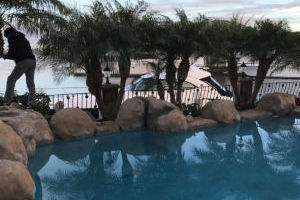
Luxenberg Pool Before Remodel
In 2018, Don Gentili of Gentili Custom Pools was contracted by Dr. Mathew Luxenberg, a Plastic Surgeon residing in Huntington Beach, CA, to remodel his existing pool increasing the size and depth. Not so bad, knock out a few walls, lower the floor that’s Don’s bread and butter. After all, Don’s been building pools since 1987.
Dr. Luxenberg also wanted to add an infinity wall. No problem. Don had done plenty of those.
However, Don’s client also wanted to expand the pool approximately 6 feet to within 1 inch of the sea harbor wall while keeping the existing pool intact not knowing that the excavation hole is going to flood during high tide. Every day. Twice.
Ah, that’s when things become interesting.
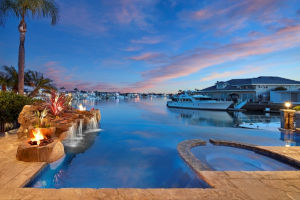
Luxenberg Pool After Remodel
That was Don Gentili’s challenge. So, what do you do? Well, according to Don, you cut the pool in half. And that’s what he did.
Dr. Luxenberg has a beautiful home and property up against the Huntington Beach Harbor the problem was that due to the landscaping and pool placement, he couldn’t really enjoy his spectacular view. Time to make a change; remove the shrubbery, retain the pool while adding onto it too, essentially, move it closer to the sea wall.
Don had a plan. Cut the pool in half, discard the half nearest the water, extend the pool hole to the sea wall and re-build the pool tying it to the pre-existing pool, all the while maintaining exact and consistent waterline tile levels while increasing depth and adding a 40 infinity wall. Piece of cake!
The only one who didn’t appreciate Don’s plan was Mother Nature. After engineers conducted soil testing, it was apparent that the seawater was going to flood the excavation hole twice a day during high tide, and nothing was going to stop it. Not even 10 industrial-sized pumps, Don discovered.
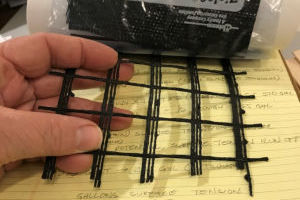
So, Don got out his sea tide charts (doesn’t every pool builder have sea tide charts handy?) and his schedule and tried to schedule around high tide. After a week or so, he realized trying to fix the problem with scheduling was hopeless. He had to figure another way. That’s when it hit him: GeoGrids, a technique he had used in the past. The goal was to build a solid foundation upon which to build and obstruct the water.
A GeoGrid is a special material that impedes rock and dirt from penetrating but allows water to seep. Don placed a layer of GeoGrid woven cloth on the pool floor. He poured 6 of gravel and vibrated to form a solid base. Next came a GeoGrid Mat to lock in place. Add another 6 of gravel, steel, and 12 of gunite. Voila! Don finally had a firm floor on which to work! The remaining two-thirds pool could be built!
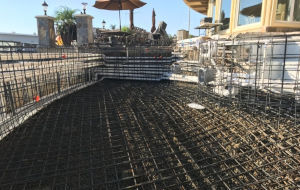
Don was finally ready to call out the masonry expert, Steve Bender of Gardner Outdoor and Pool Remodeling. Steve and his crew of craftsmen did a masterful job of tiling the newly expanded pool/spa and infinity edge to create that perfect illusion of not knowing where the pool ends, and the sea begins.
Of course, to perfectly create that illusion, Don knew there was only one acceptable finish choice for the pool and spa; Pebble Sheen Ocean Blue. Not only did Don know from years of experience that this magnificent pool deserved Pebble Tec’s quality, but that specific color would give the illusion of a seamless transition from pool to the harbor water. It was a perfect match.
Where Dr. Luxenberg had a 30 by 12 pool in the middle of his yard, he now has 41 x 17 award-winning infinity-edge pool hugging the harbor wall for a phenomenal and unforgettable view.
Don figured out that while you can’t fight Mother Nature, you can, sometimes, find a compromise.
Incorporating Waterline Glass Tile into Your Pool Remodel
One of the most elegant and in-demand design touches for today’s modern swimming pool is glass tiles instead of porcelain. While more expensive, glass tile can turn a humdrum pool into a designer’s showpiece. While you could tile an entire pool or spa with glass tile, that will typically, blow the budget out of the water (pun intended). Adding to only the waterline or even step trim can add that much desired bling while remaining at a reasonable price. There are some things you should know, however.
1. A Dazzling Alternative
The stunning beauty of glass tile is undeniable. Shimmering tiles of many different colors and shades transform what may otherwise be a standard pool design into a jaw-dropping award-winning work of art.
What makes glass tile even more attractive is its appearance underwater. Once submerged below the water’s surface, both the reflection and refraction of light create a dynamic array of glimmering shades of color.
2. Durable and Long Lasting
Glass tile is not as fragile as it might sound. This is highly-tempered glass, made especially for pools, and will be as durable as standard porcelain tile. However, you must be aware that only an experienced contractor will know the differences in the installation process. They will need different mortar materials and processes, so confirm that your contractor has plenty of experience or you may find glass tile discoloring or popping off.
3. A Low Maintenance Option
Glass pool tiling requires minimal maintenance. A quick brushing along the waterline is often all your glass tiles will need to return to their former luster. This should be done once or twice a week to prevent the growth of calcium deposits which can be more challenging to remove and require a bit more elbow grease.
4. Important Considerations Before Taking the Plunge with Glass Tiles
Glass tile installation is going to cost quite a bit more than regular tile. Not only does the actual glass tile cost more than porcelain, but the materials required for a quality installation are also more expensive. Glass tile requires a more expensive mortar, possibly waterproofing the sub-surface and a 2nd visit by the contractor to grout and finish the job. Regular porcelain tiles can be installed and grouted on the same day. Keeps the job on schedule and saves an extra trip. Glass tile, however, needs to cure for 21 days or per the manufacturer’s recommendations before grouting.
This means that the installer has to make a special trip back to the pool just to grout for which he will charge. Note that the glass step trim does not require any delay in the work process because step trim tile is not grouted. The pool finish permits some breathability around the glass trim allowing it to cure. While glass trim won’t have the same visual impact, especially from the kitchen window, it does provide that added sparkle when stepping down into the pool.
Remember, as with all aspects of your pool project, the quality of the workmanship will play a major role in the beauty and longevity of your glass tiles. Glass tile projects are more complex, making it imperative that you choose a pool remodeling company that is very experienced in working with this unique type of tiling.
About The Company
Gardner Outdoor and Pool Remodeling has been serving the Southern California area since 1969. As one of only 50 licensed PebbleTec® applicators in the entire United States and the exclusive SoCal referral partner of Leslie’s Pool Supplies, Gardner Remodeling is the premier pool contractor in San Diego County, LA County, Orange County, and Palm Springs.
Gardner Outdoor and Pool Remodeling completes over 1,600 projects each year and has completed over 44,000 projects in the Southern California area. They focus solely on swimming pools and the surrounding landscaping and specialize in all aspects of pool remodeling, including pool finishes, pool tile, pool coping, pool mosaics, plumbing and electrical work, and both commercial and residential swimming pools.
As the only pool remodeling company with three showrooms to serve you – in El Cajon, Orange, and Indio – Gardner Outdoor and Pool Remodeling has over 170 employees and has three levels of management to ensure the quality of every project. Gardner Remodeling maintains an A+ rating with the BBB and is certified by the ASPS, IPSA, and National Plasterers Council. Take a look at their gallery for inspiration and contact them to get started on your pool remodeling project.
Understanding the Three Types of Pool Filters
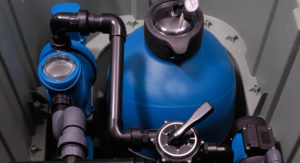 When it comes to filtering your pool water, there are three options currently available — Diatomaceous Earth (DE), cartridge and sand. While having a choice is always nice, deciding between these three pool filter options can be difficult for any pool owner, whether they’re just building a pool, remodeling an existing one or replacing equipment.
When it comes to filtering your pool water, there are three options currently available — Diatomaceous Earth (DE), cartridge and sand. While having a choice is always nice, deciding between these three pool filter options can be difficult for any pool owner, whether they’re just building a pool, remodeling an existing one or replacing equipment.
In this post you’ll find all of the information you need to know so that you will be able to choose the right pool filter for your budget, pool and lifestyle.
Quick Basics About Pool Filters
All three types of filters use a screening process to remove dirt from your pool water. They are all rated (or sized) in two ways:
- Filter rate
- Filter area
The filter rate is measured in how many gallons of water can be filtered per minute (GPM) and per square foot of the area being filtered. The filter area is the total surface area of the filter area and is measured in square feet.
Pool filters are measured in the number of contaminants they are able to remove from the water. These are measured in “microns” (short for micrometer or one millionth of a meter). The lower the number of microns which can be removed by the filter, the more efficient it is.
Diatomaceous Earth (DE) Filters
Here are a few important details about Diatomaceous Earth filters:
- Can filter particles 2 microns or larger (best on the market)
- Keeps water the cleanest
- Requires more maintenance
- Not permitted in all communities
- Most expensive filter option
DE filters are literally made up of ground-up dinosaur bones. This filter is the most efficient and the most effective on the market as the DE powder is able to coat and then trap the dirt while water flows through the powder.
As effective as they are, there are downsides to owning this type of filter. Apart from not always being permitted in municipalities due to waste, they require the most maintenance (backwashing). Some states also require a separation tank if you choose to use a DE filter, as this keeps DE powder from entering public streams and sewers. The tank will also need to be taken apart one to two times a year for cleaning.
Cartridge Filters
Here are a few important details about cartridge filters:
- Can filter particles 10 microns or larger
- Zero waste
- Operates at a lower pressure than DE filters
- Doesn’t require a multiport valve (no additional plumbing) which saves money and water
- Considered the most environmentally friendly
Cartridge filters use pleated polyester to filter unwanted dirt and debris from your pool water. It’s arguably the easiest to maintain since it doesn’t require constant backwashing to remove pool chemicals. When it does require maintenance, it can be easily rinsed with your garden hose.
The downside to this type of filter is its lifespan. Unlike the other two filter options, which can last five years or more, cartridge filters will need to be replaced after two to three years of use.
Sand Filters
Here are a few important details about sand filters:
- Least expensive option
- Most popular filter type
- Oldest type of pool filter
- Least efficient (can filter up to 30 microns)
- Rarely needs backwashing
Inside each sand filter is a layer of #20 US grade silica sand (though some may contain ZeoSand or Filterglass which will increase its efficiency). As water enters the top of the filter, it is evenly distributed across the sand bed’s surface and pushed to the bottom of your filter. The fine grains of sand then trap and hold the dirt particles found in your pool water.
Sand filters will initially filter to a smaller particle size. But as the filter becomes dirtier and the flow of water decreases, the pressure rate will increase. For the filter to effectively do its job, it should be backwashed or cleaned when a pressure rate of seven or eight psi is reached.
A sand filter won’t leave your pool water as clean and clear as a DE filter or cartridge filter. But what makes it a popular choice for pool owners is its affordability and lack of maintenance. Apart from backwashing the filter, the sand will only need to be changed about once every seven years.
Don’t Pick a Filter Without Looking At Your Pump
Your pool filter and pump need to work in harmony in order to keep your pool water clean and healthy. As we touched on earlier, each filter has a gallons per minute (GPM) rating per square foot. For optimal pool operation, the filter flow rate must be equal to or greater than the GPM of your pool pump. As a general rule of thumb, your filter should have a minimum of 1 square foot for every 10,000 gallons of your pool’s capacity.
Pick the Right Pool Filter with a Trusted Pool Professional
Still in doubt about which filter is best for your pool? Give the pool renovation experts at [company name] a call for expert advice and guidance from an experienced pool professional.
About The Company
Gardner Outdoor and Pool Remodeling has been serving the Southern California area since 1969. As one of only 50 licensed PebbleTec® applicators in the entire United States and the exclusive SoCal referral partner of Leslie’s Pool Supplies, Gardner Remodeling is the premier pool contractor in San Diego County, LA County, Orange County, and Palm Springs.
Gardner Outdoor and Pool Remodeling completes over 1,600 projects each year and has completed over 44,000 projects in the Southern California area. They focus solely on swimming pools and the surrounding landscaping and specialize in all aspects of pool remodeling, including pool finishes, pool tile, pool coping, pool mosaics, plumbing and electrical work, and both commercial and residential swimming pools.
As the only pool remodeling company with three showrooms to serve you – in El Cajon, Orange, and Indio – Gardner Outdoor and Pool Remodeling has over 170 employees and has three levels of management to ensure the quality of every project. Gardner Remodeling maintains an A+ rating with the BBB and is certified by the ASPS, IPSA, and National Plasterers Council. Take a look at their gallery for inspiration and contact them to get started on your pool remodeling project.
What is Pool Mottling and Can It Be Fixed?
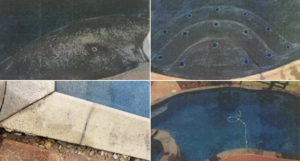
Pool mottling, the variations in the color of cement or pool plaster, is a common concern among pool owners and pool remodelers alike. Ranging from unnoticeable to severe, the mottling of pool finishes like quartz and plaster, as well as cement decks, is unpredictable and can happen to any pool.
While pool mottling may sound serious, it is an aesthetic issue that has no impact on the strength and durability of your pool. In fact, cement mottling can be seen all around us in everyday environments such as on sidewalks and most people don’t even notice.
Why Does Pool Mottling Occur?
Each pool finish and deck will have some level of pool mottling. This is due to a variety of issues including hydration and the troweling process.
Mottling is more apparent in darker plaster and quartz finishes. But it can also show up in lighter shades of plaster, as well.
Can Pool Mottling Be Treated?
Very little can be done to remedy the effects of mottling on cement decks and plaster finishes. This is due to how muriatic acid affects the plaster itself.
Sometimes, depending on severity, the appearance can be improved by an in-pool acid wash. Extreme cases may require the pool to be drained and acid applied directly on the finish.
For quartz pool finishes, an acid wash might be able to reduce the appearance of mottling.
Mottling of some form can be found among the poolscapes of nearly every pool. If it is a concern, there are higher-end pool finish options such as Pebble Tec and Pebble Sheen which experience little to no mottling or simply select a white plaster or quartz finish to minimize mottling.
San Diego Pool Remodeling Experts
When it comes to protecting your investment, the pool remodeling experts at Gardner Outdoor and Pool Remodeling have your best interest in mind. Contact us today to learn more about all of our remodeling services and how we can help keep your pool healthy and functioning at its maximum efficiency.
About The Company
Gardner Outdoor and Pool Remodeling has been serving the Southern California area since 1969. As one of only 50 licensed PebbleTec® applicators in the entire United States and the exclusive SoCal referral partner of Leslie’s Pool Supplies, Gardner Remodeling is the premier pool contractor in San Diego County, LA County, Orange County, and Palm Springs.
Gardner Outdoor and Pool Remodeling completes over 1,600 projects each year and has completed over 44,000 projects in the Southern California area. They focus solely on swimming pools and the surrounding landscaping and specialize in all aspects of pool remodeling, including pool finishes, pool tile, pool coping, pool mosaics, plumbing and electrical work, and both commercial and residential swimming pools.
As the only pool remodeling company with three showrooms to serve you – in El Cajon, Orange, and Indio – Gardner Outdoor and Pool Remodeling has over 170 employees and has three levels of management to ensure the quality of every project. Gardner Remodeling maintains an A+ rating with the BBB and is certified by the ASPS, IPSA, and National Plasterers Council. Take a look at their gallery for inspiration and contact them to get started on your pool remodeling project.
Pool Tile Ideas & Inspiration
Looking for pool tile ideas and inspiration for your pool remodeling project? Swimming pool tile can make a beautiful and dramatic statement in your backyard. With so many designs and material choices, homeowners have many options — including color, size, texture, and designs.
Did you know there are different pool tiles for different elements in your pool? Let’s look at the benefits of each pool tile and the different terminology so you choose the right ones for your pool.
Versatility, Durability & Beauty
Swimming pool tile has many benefits. If you’re looking to remodel and resurface your pool, consider how tile offers a custom look. Your pool tile idea can either add a focal point that pops or one that offers a more blended look, for example:
- Customized designs to enhance your pool and backyard area – mix and match more than a single tile choice
- Available in a variety of sizes – just be aware that the smaller the tile, the more grout lines you will see.
- Create vignettes — you don’t have to restrict your design to a single look for all the elements on a pool, spa, spa dam wall and raised walls (Raised Bond Beams). Just like in a home, tile can be used effectively to create a “designer” look
- Retain finishes while updating tile – not ready to replaster but want to create a new look? No problem – a contractor can replace tiles while saving your pool finish.
Ideas for Each Pool Tile Type
Pool tile can be used in various areas of a swimming pool. When remodeling a pool, keep these tile types in mind when creating your new design:
- Waterline Tile – This is the layer of tile (usually 6”) at the top edge of your pool located just below the coping or deck. Waterline tile is typically the first design element you see when looking at your pool. Have a unique pool tile idea? Then your waterline tile provides an opportunity to show off a compelling design like a mosaic or mix two different tiles to make a designer look.
- Trim Tile – This is the tile you see on the leading edge of steps and benches. It’s required for commercial pools and is used in residential pools to create dramatic accents. Trim tile — especially in contrasting colors — helps you see the edges of steps which adds a safety element that is also beautiful to look at.
- Spillway Tile – Typically spillway tile is the same as the waterline tile, but you can vary the spillway (where there’s a notch in a spa dam wall) to provide an additional accent.
- Raised Bond Beams – Whenever the wall of a pool is higher than deck level, that’s called a Raised Bond Beam. You can cover the beam with tile, stone, natural or manufactured materials depending upon your pool design.
Pool Tile Materials
Natural stone, manufactured stone, and porcelain tiles are commonly used in pools today. Ceramic tile, which is usually used in kitchens, bathrooms and other interior applications, are not recommended for pools. Ceramic will slowly disintegrate in a pool due to the water chemistry. Confirm that your final tile choices are approved for pool usage!
When shopping for swimming pool tile, look for natural or manufactured stone tile or porcelain tile.
Natural or Manufactured Stone Tile
When you want to create a natural atmosphere — like a river, lake or pond — then natural or manufactured stone is a wonderful pool tile idea. It’s available in a variety of sizes and textures in subtle earth tones. It’s durable, slip resistant and retains the warmth of a hot summer day.
Porcelain Tile
The most common type of swimming pool tile is made of porcelain. It retains its original look with basic maintenance. The reason porcelain tile holds up against pool chemicals is that porcelain is fired at a much higher temperature.
Before You Decide to Consult An Expert
Before you decide on which pool tile idea is ideal for your backyard, talk with an expert to understand all the pros and cons related to your remodeling project. At Gardner Outdoor and Pool Remodeling, we will present options that best fit your needs and budget.
What you should know before you Acid Wash your Pool
An acid wash is typically used to remove or lessen the appearance of stains on a pool’s plaster surface. While using chemicals to reduce staining is less expensive than replastering, it is important for a homeowner to understand the benefits and risks. There are two ways to apply the chemicals. It depends if the pool is empty or not.
The Downside of Acid Washes Over Replastering
While acid washing can dramatically reduce stains or remove spots from a pool’s surface,
It can shorten the lifespan of plaster finishes. Muriatic Acid, the chemical commonly used is dangerous and corrosive, so the application should be done by a professional. However, Muriatic Acid does not damage quartz or pebble aggregate finishes.
Without Draining Your Pool
This type of acid washing may be the right solution, especially if your pool plaster has minor staining. The muriatic acid is added to the water and will perform a good cleaning. You cannot use the pool while the chemical is active. Once the water has been neutralized and the chemicals are rebalanced, it is safe to resume swimming.
Applying to an Empty Pool
If you’ve decided to empty the pool for other maintenance, you’ll need to decide if it’s worth acid washing or to refinish. It’s important to note that acid washing is the final step for the application of a new finish such as aggregate, glass and Hydrazzo. Acid washing cleans the surface, removing haze or cement residue during the resurfacing process.
Important Considerations
- The chemicals used in an acid wash are dangerous and corrosive. It is best left to professional, as they will know the correct amount based upon pool size and the intensity of staining.
- Acid washes are ideal for minor discolorations caused by things like leaves falling into the pool.
- The main benefit of acid washing, during some new finishes application is to remove any haze or cement residue.
- California is experiencing a long-term drought. Besides the cost of the acid wash, you’ll need to calculate the cost of refilling the pool (including any water fines).